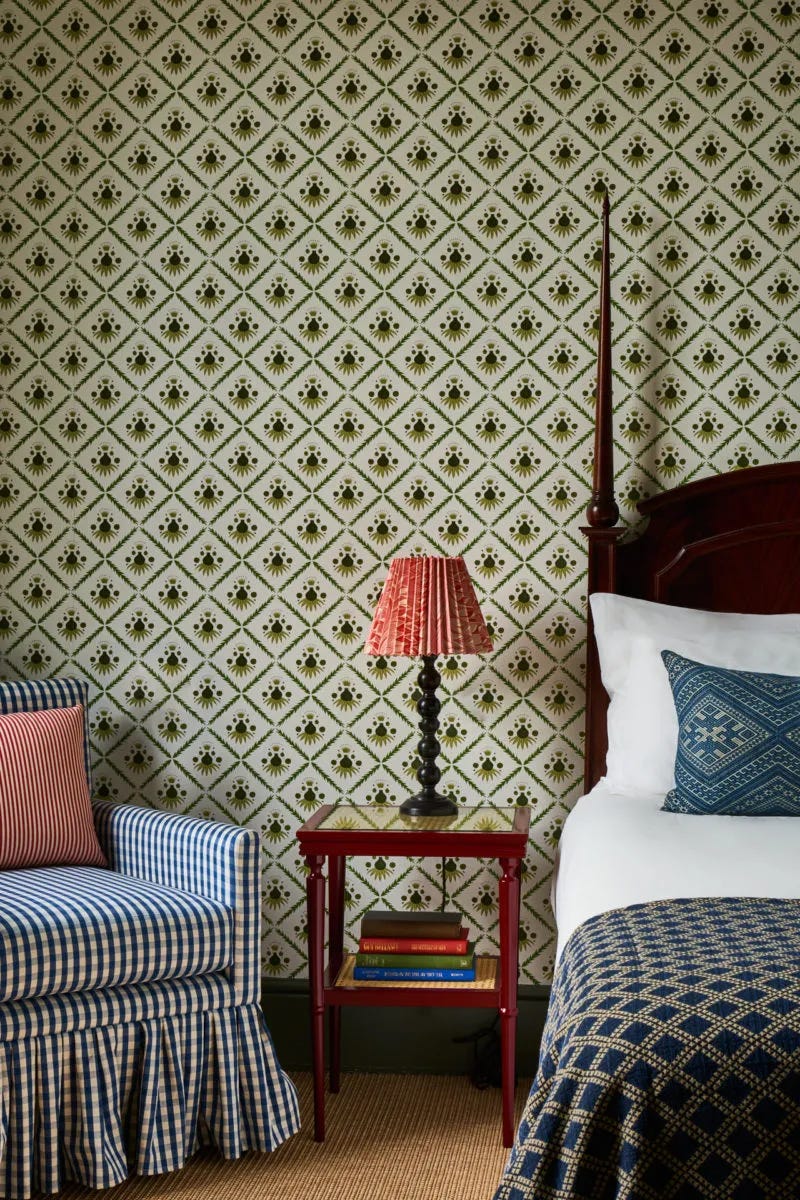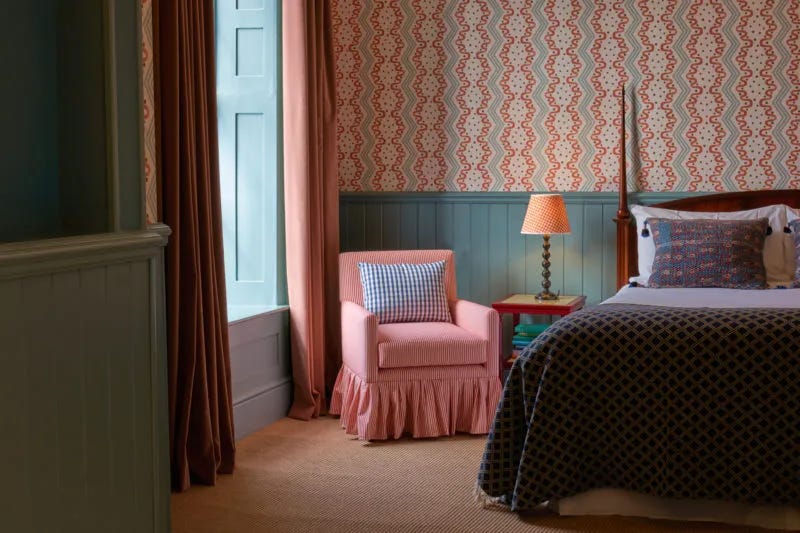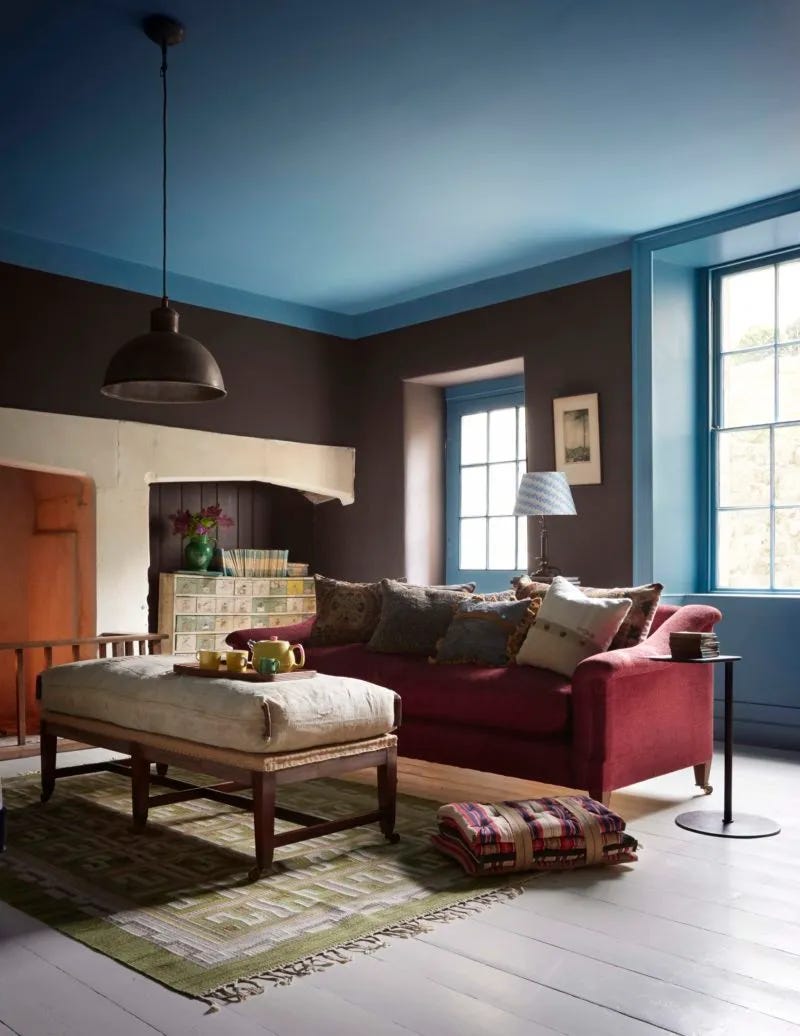Designers in conversation: Nicola Harding
The first in an occasional interview series. Plus, for paid subscribers, her complete guide to getting your lighting right
Nicola Harding is one of my favourite interior designers. It was her work that I referenced when I first noticed the importance (and joy) of bringing a disruptor colour into every scheme – and she is also fully committed to being as sustainable as possible in an industry known for its wastefulness.
Nicola is one of House & Garden’s Top 100 designers and heads up a team of 16. Projects include not only her own home, but everything from a Notting Hill Arts and Crafts villa to a Victorian Thames-side mansion and a timber-framed eco new-build in Surrey.
Of her own house, she admits it was a big project, but adds: “It wasn't like a client project, where you have the money to do everything all at once – it was done in stages.”
So where do you start?
“Do a chunk at a time, but think about the whole masterplan so you don’t have to do things twice if you can avoid it.” she says. “Think about the floor plan and [mentally] take out the bathrooms and kitchen so you are just looking at the shapes of the rooms. And then ask yourself what your life really looks like.
“For example, it used to be that washing machines automatically went into the kitchen, but most of the laundry is created upstairs, so can you shoehorn a washing machine upstairs – perhaps in a cupboard on the landing?”
As a designer known for paying attention to sustainability, Nicola also advises re-using, wherever and whatever you can.
“It’s as much about what you buy as how much you buy,” she says. “The biggest element of our carbon footprint is consumption, so if you can make better use of something or re-use it and avoid buying something new, that’s the best possible scenario.”
“Turn on your inner Granny – she would be horrified at how much we throw out. Her philosophy was all about mend and re-imagine.”
True to form, Nicola re-used a pink bathroom suite that was in her house when she moved in. “We moved it to another room and created a loo under the stairs. We teamed it with new reclaimed brass taps and a much nicer loo seat. So now we have 70s pink sanitaryware against chocolate brown panelling and a lime green wallpaper off-cut that was left over from another project.”
When it comes to inspiration, Nicola cites movies and television as a big part of it –specifically Mad Men and Queen's Gambit with their “intoxicating” interiors sets. But she knows her historical references, too.
“Set designers use colour combinations to take us emotionally to a place in history and to create an atmosphere and a feeling.”
In common with many who grow up to be interior designers (Sophie Ashby, Kelly Hoppen) Nicola moved house a lot as a child and, like both of those, was always “really questioning what home means”.
This has informed her design process – and when discussing plans with clients she always delves into their childhood memories. “It’s very personal. You just keep asking the same question from a different angle and you will tease the answer out: what is your favourite holiday place, which time of year do you like, what was the best moment of your childhood, what did you want Christmas to look like? And then you dive into that picture of the mood and colours.”
“Using vintage is a cheap trick because it immediately gives a room a sense of permanence by putting one foot in the past and one in the present. Getting it right is trial and error. I like things that don’t feel too perfect. I like something that is unexpected or clashing.”
What advice does she have for those who don’t live in buildings full of original features? What if you live with low ceilings, in square rooms with not a cornice or sash window in sight?
“Look at the things you touch – doors and handles – sometimes those can be really lightweight in new-builds, so add reclaimed doors and [good quality] handles.
“Panelling is a way of not just adding a layer of decor – in some newer houses the acoustics aren’t great as the walls are thin, so by adding extra layers you are improving that aspect, too.”
But can it ever work adding large Georgian-style panels to a new-build flat? Yes, says Nicola, but you have to make sure you choose the right style for the space. There are so many different types of panelling – from grand, large-format to a more low-key tongue and groove that would have been used in the servants’ rooms at the back of the house – so in a smaller property, think about using a more compact panelling style, she advises. She also often uses a wider board and fits it horizontally, as you see above.
“For me the matchboard panelling (tongue and groove) is my favourite as it's cosy. In hotels with big grand rooms, it’s almost always the smaller spaces that people actually like best, because they are cosy. I relish those spaces.”
Finally, what about sustainability? As has been pointed out on these pages more than once, it can be an expensive option.
“The process of undertaking work to your home involves a lot of purchasing and at that point you are a consumer and that gives you a huge opportunity to use your purchasing power to affect some good. It is easy to give up before you even start because it can be so overwhelming and so you think, ‘oh, I can’t do any of it so I will do none of it’, but even the smallest step does make a difference.
“It doesn’t need to be that you are buying some crazy chair made out of a hay bale, it could just be repurposing your Granny’s chest of drawers. That is already doing a better job than buying something that you aren’t in love with and that you will end up replacing.
“Have that masterplan and don’t make kneejerk decisions and if you love it, it will work – a piece of vintage furniture or a colour, or the unexpected clashes of things going next to each other are fun.”
Does she have any decorating regrets:?
“I regret the things I didn’t do more than the things I did – should have taken more risks, had more fun and worried less.”
Sound advice for us all, I think.
Now Nicola is running interior design classes at her studio in north-west London. “The next one is on 14 June at Nicola Harding & Co, 31 Lonsdale Road, London NW6. Doors open at 9.30am with coffee, tea and pastries served on arrival, and again during the mid-morning break. A light lunch will be provided in our ground floor supper room. There will also be afternoon breaks with refreshments provided. The day costs £650 and if you can’t make that one, there will be another on Friday 6 September 2024.”
Paid subscribers can read on to discover Nicola’s lighting tips and use a 15 per cent discount code, not only for her gorgeous lights but across her Nix product range.









